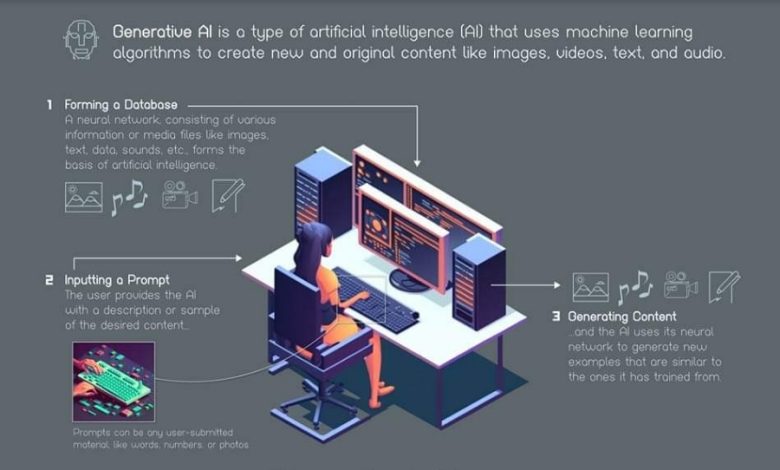Exploring the Power of Conversational AI ChatGPT: How To Use ChatGPT-3, ChatGPT-4, ChatGPT-5 for Free Step By Step Guide

Exploring the Power of Conversational AI ChatGPT: How To Use ChatGPT-3, ChatGPT-4, ChatGPT-5 for Free Step By Step Guide
Are you ready to delve into the exciting world of Conversational AI? With the advent of advanced language models like ChatGPT-3, ChatGPT-4, and ChatGPT-5, you can now create engaging and interactive conversations without breaking the bank. In this blog post, we’ll guide you through the steps to unleash the potential of these remarkable tools for free.

What is ChatGPT?
ChatGPT is a cutting-edge language model developed by OpenAI that can generate human-like text based on the input it receives. This technology has been employed in various applications such as chatbots, virtual assistants, content creation, and more. It’s capable of understanding context, generating coherent responses, and even imitating different writing styles.
Versions of ChatGPT
As of my last knowledge update in September 2021, ChatGPT had reached version 3.5. Since then, newer versions might have been released, such as ChatGPT-4 and ChatGPT-5. These versions are expected to offer even more impressive capabilities, improved context understanding, and enhanced text generation.
Accessing ChatGPT for Free
While the advanced versions of ChatGPT might come with associated costs, there are ways to access and utilize their capabilities without spending a dime. OpenAI often provides free access to their models through research previews or limited-time promotions.
Here’s how you can get started:
- Research Previews: Keep an eye on OpenAI’s announcements and research previews. These previews allow users to experiment with the latest versions of ChatGPT and experience their capabilities firsthand.
- OpenAI Playground: OpenAI’s Playground is a user-friendly interface that allows you to interact with their language models. During research previews, you might find access to ChatGPT versions for free usage. Simply visit the OpenAI Playground and start engaging in conversations with the AI.
- Hackathons and Contests: OpenAI occasionally hosts hackathons, contests, and challenges that provide participants with free access to their models. Participating in such events not only lets you explore the technology but also gives you a chance to win rewards.
- Educational Initiatives: OpenAI often partners with educational institutions to offer free access to their models for learning purposes. If you’re a student or a part of an educational program, keep an eye out for such opportunities.
- Free-Tier Accounts: OpenAI might introduce free-tier accounts that grant users limited access to their models. While the capabilities might be constrained, it’s still a great way to get a taste of the technology.
Getting the Most Out of ChatGPT
To make the most of ChatGPT, regardless of the version, consider the following tips:
- Clear Prompts: Provide clear and concise prompts to help the AI understand your intent.
- Experimentation: Don’t hesitate to experiment with different prompts, styles, and contexts to see what works best.
- Contextual Details: When engaging in conversations, include relevant contextual details to ensure coherent responses.
- Prompt Engineering: Craft prompts that guide the AI toward the desired outcome. For example, if you’re looking for a creative story, frame your prompt accordingly.
- Review and Edit: Generated text might not always be perfect. Review and edit the AI’s responses to refine the output.
Understanding the difference between ChatGPT3, ChatGPT4, and ChatGPT5

ChatGPT3, ChatGPT4, and ChatGPT5 are the three versions of the ChatGPT model. Each version is an improvement on the previous one, with a larger training corpus, more parameters, and greater accuracy.
ChatGPT3 has 175 billion parameters and is the most powerful version of the model. It has been used to generate realistic text and even write entire articles that are difficult to distinguish from those written by humans.
ChatGPT4 has 202 billion parameters, making it even more powerful than ChatGPT3. It is not as widely available as ChatGPT3 but can still be used for a variety of applications.
ChatGPT5 is the latest version of the model, with 300 billion parameters. It is currently in development and not yet available for public use.
How to use ChatGPT3 for free
OpenAI offers a beta version of their API that allows users to access ChatGPT3 for free. The API has a generous free tier that allows for up to 100,000 requests per month.
To use ChatGPT3, you will need to sign up for an API key on the OpenAI website, Get your API key HERE. Once you have the API key, you can integrate it into your application or use it directly through the OpenAI Playground. The Playground allows you to interact with the model through a web interface and generate text in real-time.
How to use ChatGPT4 for free
Using ChatGPT4 for free is a bit more challenging than using ChatGPT3. Since ChatGPT4 is not as widely available, there are fewer resources and tools available for it. However, there are still ways to access the model for free.
One option is to use Hugging Face, an open-source platform for natural language processing. Hugging Face has a pre-trained version of ChatGPT4 that can be accessed through their API. The API has a free tier that allows for up to 5,000 requests per month.
Another option is to use Colab, a free online platform for data science and machine learning. Colab allows you to run Jupyter notebooks in the cloud and provides access to GPUs for faster processing. You can use Colab to run pre-trained models, including ChatGPT4, and generate text.
Is ChatGPT5 Out Yet?
ChatGPT5 is currently in development and not yet available for public use. However, there are rumors that OpenAI may release a beta version of the API in the near future. Keep an eye on the OpenAI website for updates.
Advantages of using ChatGPT for chatbots and customer service

ChatGPT has several advantages over traditional rule-based chatbots and customer service systems. One of the main advantages is its ability to generate human-like responses that are contextually relevant. This makes the conversation more natural and engaging for the user.
Another advantage is its ability to learn from the context of the conversation. This means that the model can adapt to the user’s needs and preferences over time, providing a more personalized experience.
ChatGPT can also handle a wide range of tasks, from answering simple questions to providing complex recommendations. This makes it a versatile tool for a variety of applications.
Tips for using ChatGPT effectively
To use ChatGPT effectively, it is important to keep in mind some best practices. One of the most important is to provide clear prompts and context for the model. This will help the model generate more accurate and relevant responses.
It is also important to monitor the output of the model and provide feedback when necessary. This will help the model learn and improve over time.
Finally, it is important to set expectations for the user and let them know that they are interacting with a machine. This will help avoid confusion and frustration.
Examples of successful ChatGPT applications
ChatGPT has been used in a wide range of applications, from creative writing to customer service. One successful application is the GPT-3-powered chatbot developed by AI startup DALL·E. The chatbot is able to generate realistic responses to a wide range of prompts, providing a personalized and engaging experience for users.
Another successful application is the AI-powered writing assistant created by Writesonic. The assistant uses ChatGPT to generate copy for ads, websites, and social media posts, saving time and improving the quality of the content.
ChatGPT alternatives
While ChatGPT is a powerful tool for natural language processing, there are several alternatives available. One popular option is BERT, another AI language model developed by Google. BERT is designed for a wide range of applications, including text classification, question answering, and language translation.
Another option is GPT-2, the predecessor to ChatGPT. GPT-2 has 1.5 billion parameters and has been used in a variety of applications, including creative writing and chatbots.
Research Previews: A Glimpse into the Future of AI

In the ever-evolving landscape of artificial intelligence, research previews have emerged as a key gateway for users to experience and contribute to cutting-edge technologies. These previews, often offered by organizations like OpenAI, provide a unique opportunity to explore and interact with the latest advancements in AI models, like ChatGPT, before they are fully launched to the public. Let’s dive into the world of research previews and understand their significance in shaping the future of AI.
What Are Research Previews?
Research previews offer users a sneak peek into the capabilities of upcoming AI models and technologies. These previews are typically made available for a limited time to gather user feedback, refine the models, and identify potential issues before the official launch. During this phase, users can experiment, test, and provide valuable insights that help improve the models’ performance and reliability.
The Role of OpenAI in Research Previews
OpenAI, a pioneer in AI research and development, has been at the forefront of offering research previews for their advanced language models like ChatGPT. By providing users with access to models in development, OpenAI fosters a collaborative environment where researchers, developers, and enthusiasts can collectively contribute to the models’ growth.
Benefits of Research Previews
- User Feedback: Research previews enable users to provide real-world feedback on the AI models. This feedback loop helps developers fine-tune the models and address any issues or limitations that may arise.
- Improvement Iterations: The insights gained from user interactions during research previews allow developers to iterate and refine the models for enhanced performance and accuracy.
- Community Collaboration: These previews encourage a sense of community involvement, where users come together to explore the technology, share their experiences, and even suggest novel use cases.
- Testing New Features: Research previews offer a platform to test new features, functionalities, and capabilities of AI models in a controlled environment before they are officially rolled out.
- Real-World Applications: Users get a chance to experiment with the models and explore potential applications across various industries, from content creation to customer support and more.
Getting Involved in Research Previews
Participating in research previews requires keeping an eye on announcements from organizations like OpenAI. Here’s how you can get involved:
- Stay Informed: Follow the official communication channels of AI organizations to receive updates on upcoming research previews and opportunities for early access.
- Experiment Creatively: Once you gain access, don’t hesitate to experiment creatively with the AI models. Test different prompts, use cases, and scenarios to explore the extent of their capabilities.
- Provide Feedback: Take an active role by providing feedback on your experiences. Highlight what worked well and point out areas where improvements could be made.
- Engage in Communities: Join online forums, social media groups, and discussion platforms related to AI. Engaging with fellow enthusiasts can expand your understanding and inspire new ideas.
Exploring Possibilities: A Guide to the OpenAI Playground
In the realm of artificial intelligence, experimentation and exploration are key to unraveling the potential of advanced technologies. The OpenAI Playground stands as a dynamic platform that allows users to interact with AI models in a user-friendly and engaging manner. In this article, we’ll take you on a journey through the OpenAI Playground, revealing its features, capabilities, and how you can harness its power to create, learn, and innovate.
Introduction to the OpenAI Playground
The OpenAI Playground is an interactive interface that grants users access to AI models, enabling them to generate text, have conversations, and experience the capabilities of these models firsthand. While it was initially developed to showcase the potential of OpenAI’s language models, it has evolved into a versatile tool for various applications.
Key Features of the OpenAI Playground
- Text Generation: The playground lets you generate text based on the prompts you provide. Whether you’re looking to draft content, brainstorm ideas, or simulate dialogues, the AI’s text generation can be a valuable resource.
- Conversational AI: Engage in interactive conversations with the AI. This feature is particularly useful for creating chatbots, virtual assistants, or even practicing your conversational skills.
- Prompt Customization: Craft prompts tailored to your specific needs. Experiment with different styles, tones, and contexts to observe how the AI responds.
- Language Translation: Translate text between languages using the AI models. This feature can be beneficial for language learners and cross-lingual communication.
- Idea Generation: Struggling with writer’s block? Use the AI to generate creative ideas, prompts, or story starters.
- Learning Resource: The playground can serve as an educational tool, offering insights into AI capabilities and language modeling techniques.
Getting Started with the OpenAI Playground
- Access the Playground: Visit the OpenAI Playground on the OpenAI website. Depending on the availability of models, you might be able to interact with various versions, including ChatGPT-3, ChatGPT-4, and more.
- Choose a Task: Decide what you want to achieve with the AI. Are you looking to generate content, simulate a conversation, or explore a particular topic?
- Craft a Prompt: Frame your prompt clearly and concisely. The quality of the AI’s response often depends on the clarity of the input it receives.
- Experiment and Iterate: Don’t be afraid to experiment with different prompts, styles, and approaches. Observe how the AI adapts to your inputs.
- Review and Edit: While the AI’s responses can be impressive, they might not always be perfect. Review the generated text and edit as needed to refine the output.
- Learn and Adapt: As you interact with the AI, you’ll gain insights into its strengths and limitations. Use this knowledge to tailor your approach and achieve desired outcomes.
Ethical Considerations
While the OpenAI Playground offers exciting possibilities, it’s essential to approach its usage ethically. Be mindful of generating content that adheres to ethical guidelines, avoids bias, and respects privacy.
Conclusion
Conversational AI powered by ChatGPT has revolutionized the way we interact with technology. With versions like ChatGPT-3, ChatGPT-4, and ChatGPT-5, you can create dynamic and engaging conversations without incurring hefty costs. By staying informed about OpenAI’s offerings, participating in events, and taking advantage of research previews, you can unlock the potential of these powerful tools for free. So, go ahead and embark on your journey of conversational exploration with ChatGPT!
arewanahiya.com




